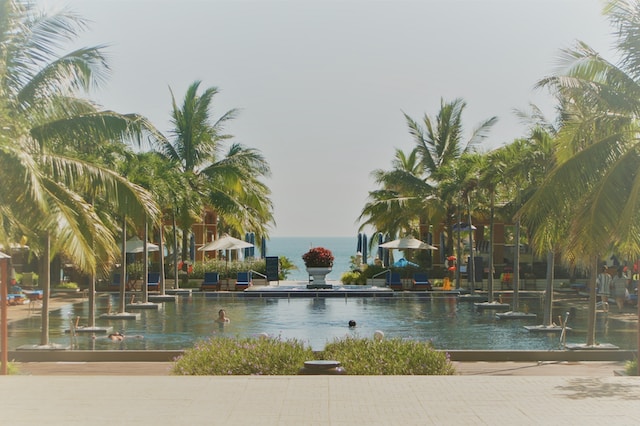Your Ultimate Digital Nomad Guide to Hoi An, Vietnam: My Story
Ever find yourself scrolling through photos of lantern-lit streets and wondering if a place that beautiful could actually be your next office? That was me before I first landed in Hoi An, Vietnam. As Jeff, a full-time traveler who people call “the chilled nomad,” I’m always searching for that perfect mix of work, culture, and relaxation.
I wondered, could this “Venice of Vietnam” really live up to the hype?
Let me tell you, it does. This guide is my story and all the secrets I learned, updated for 2025, to help you make this charming town your own remote work haven. We’ll cover everything from finding a great apartment to the best spots for a strong coffee and even stronger WiFi.
Key Takeaways
- Hoi An is a dream for digital nomads because of its incredibly low cost of living, amazing food, and stunning beaches.
- Before you book anything, you’ll need to sort out your visa. As of 2025, Vietnam’s 90-day e-Visa is the go-to option for most remote workers.
- The best weather is during the dry season, which runs from February to August. Try to avoid the rainy season from September to January.
- You’ll likely fly into Da Nang International Airport, which is just a 45-minute ride away from Hoi An.
- Getting around is a breeze. Renting a bicycle or scooter is the local way, but ride-hailing apps like Grab are super convenient too.
- The local currency is the Vietnamese Dong (VND), and while cards are accepted in bigger places, cash is king for street food and local markets.
Why I Fell in Love with Hoi An as a Digital Nomad
From the moment I arrived, I could feel the magic. The streets, lined with colorful lanterns, had this warm, welcoming glow. Hoi An turned out to be the perfect place for me to balance my copywriting work with a healthy dose of adventure. It’s a place with a low cost of living, incredible food, and some of the most beautiful beaches I’ve ever seen.
My days quickly fell into a wonderful rhythm. I’d start with a walk through the enchanting Old Town, find a cozy café, and get a few hours of work done. The whole vibe is serene, with traditional music often playing softly in the background. It’s an inspiring place to be creative.
When I needed a break, I’d hop on my bicycle and ride through the countryside, exploring lush rice paddies. And the evenings? That’s when the town truly comes alive. I’d meet up with other travelers at riverside bars, sipping cocktails and watching the lanterns reflect on the Thu Bon River. It’s a scene straight out of a postcard.

Hoi An, Vietnam
Low cost of living
One of the biggest draws for me was how affordable Hoi An is. It allows you to enjoy a high quality of life without the financial stress you might find in other nomad hotspots. My monthly budget here is a fraction of what it would be in Europe or North America.
A single person can live comfortably for around $620 to $948 a month. Rent for a nice apartment with a pool can be as low as $400-$500 per month. This financial freedom means you can say “yes” to more experiences, whether that’s an extra cooking class or a weekend trip, without constantly checking your bank account.
Excellent food options
The food scene here is a paradise. I spent my evenings exploring the night markets, discovering incredible street food. You absolutely have to try the local specialties. My personal favorites are ‘Cao Lau’, a unique noodle dish you can only find here, and the legendary ‘Banh Xeo’ Vietnamese pancakes.
For the best Banh Mi of your life, you have two legendary choices: Banh Mi Phuong, which the late Anthony Bourdain raved about, and Madam Khanh, also known as “The Banh Mi Queen.” I’ve had both, and honestly, you can’t go wrong. Beyond the street food, you’ll find everything from trendy vegetarian cafes to riverside restaurants serving the freshest seafood.
Easy accessibility
Hoi An is perfectly positioned on Vietnam’s central coast, making it super easy to get to. The closest airport is Da Nang International Airport, which is about a 45-minute drive and welcomes flights from all over the world.
Once you’re here, getting around is simple and cheap. The town is compact enough to explore on foot, and renting a bicycle or motorbike gives you the freedom to discover the surrounding countryside and beaches. This easy access makes it a seamless experience, letting you live that flexible nomad lifestyle without any travel headaches.
Beautiful beaches
When you need a break from work, the beach is just a short bike ride away. The two most popular spots are An Bang Beach and Cua Dai Beach. I personally love An Bang Beach for its laid-back vibe.
It’s lined with colorful umbrellas and beachfront bars like Soul Kitchen, where you can grab a sunbed, order a coconut, and relax. It’s the perfect place to unwind, soak up the sun, and listen to the waves. For a bit more adventure, you can even arrange snorkeling or diving trips to the nearby Cham Islands to see the coral reefs.

Pool in the heart of the Sunrise Resort in Vietnam’s Hoi An.
Essential Information for Digital Nomads in Hoi An
Before you pack your bags, there are a few practical things you need to know. Let’s get into the details on visas, weather, and money to make your arrival as smooth as possible.
Visas and immigration
Navigating visas is a key part of the nomad lifestyle. Luckily, Vietnam has made things much easier. As of 2025, there isn’t a specific “digital nomad visa,” but the government’s 90-day tourist e-Visa is the perfect solution for most remote workers.
This multiple-entry e-Visa is available to citizens of all countries and can be applied for online, making the process straightforward. While you are technically on a tourist visa, working remotely for a foreign company is a common and accepted practice among the nomad community here. There’s even talk of a potential long-term “Golden Visa” in the future, which is exciting news for those of us who want to stay longer.
Weather and best time to visit
Timing your visit to Hoi An can make a big difference. The town has two main seasons. The dry season, from February to August, is definitely the best time to be here. You’ll have sunny days perfect for beach trips and exploring the ancient town.
The rainy season runs from September to January. During these months, you can expect heavy downpours, and sometimes flooding can occur, which might disrupt your plans. It can also get quite hot and humid, especially in the summer months, with temperatures often hitting 30°C (86°F).
Getting to Hoi An
Since Hoi An doesn’t have its own airport or train station, you’ll be arriving via Da Nang.
- By Air: The most common way is to fly into Da Nang International Airport (DAD). From the airport, it’s a 45-minute trip to Hoi An. You can book a private car for about $12-$20 USD or use a ride-hailing app like Grab.
- By Train: For a more scenic journey, you can take the train to Da Nang Railway Station from major cities like Ho Chi Minh City or Hanoi, then take a taxi to Hoi An.
- By Bus: Sleeper buses are a budget-friendly option for long-distance travel within Vietnam and will drop you off right in Hoi An.
Getting around in Hoi An
Hoi An is incredibly easy to navigate, and getting around is part of the fun. Here are the main ways I explore the town:
- Bicycle: This is my favorite way to get around. The town is mostly flat, and many hotels offer free bikes. It’s perfect for leisurely rides to the beach or through the rice paddies.
- Motorbike: For more freedom to explore further, renting a scooter is a great option. They are cheap to rent, but make sure you have an international driving permit and always wear a helmet.
- Ride-Hailing Apps: Grab is the Uber of Southeast Asia and works perfectly here for both cars (GrabCar) and scooter taxis (GrabBike). It’s convenient and the prices are set in the app, so there’s no haggling.
- Walking: The Ancient Town is a UNESCO World Heritage Site and is pedestrian-friendly, with motor vehicles banned during certain hours. It’s best explored on foot.
Currency and money matters
The official currency in Vietnam is the Vietnamese Dong (VND). While some tourist-focused places might accept US dollars, you’ll get a much better deal paying in the local currency. I always recommend having some cash on hand, especially for street food vendors and small market stalls.
ATMs are easy to find all over town, and most hotels, larger restaurants, and shops accept major credit cards. A pro tip is to use a card with no foreign transaction fees to save some money. Also, get a local SIM card at the airport; a tourist plan from a provider like Viettel or Mobifone is cheap and will give you plenty of high-speed data.
Finding Accommodation as a Digital Nomad in Hoi An
Finding the right place to live is key to feeling at home. In Hoi An, you’re spoiled for choice, with options ranging from budget-friendly guesthouses to beautiful villas with pools.
Cost of accommodation
The affordability of rent is a huge plus. You can find a comfortable place to live without spending a fortune, leaving more money for everything else the town has to offer.
| Type of Accommodation | Price Range per Month (USD) | Additional Notes |
|---|---|---|
| Shared room in a guesthouse | $200 – $300 | Price often includes utilities and basic amenities. |
| Private room in a shared house | $300 – $400 | A great way to meet other people. Usually includes access to a shared kitchen. |
| One-bedroom apartment | $400 – $600 | Typically furnished with utilities included. Ideal for more privacy and comfort. |
| Two-bedroom house | $600 – $800 | Perfect if you’re traveling with a partner or friend and planning a longer stay. |
| Luxury villa | $1000 and above | Features modern amenities like a private pool and is often located in prime areas. |
Best areas to stay in Hoi An
Where you choose to live will shape your daily experience. Each neighborhood has its own unique vibe.
- The Old Town: If you want to be in the heart of the action, this is the place. It’s charming and you’ll have cafes and restaurants right outside your door. It can be a bit pricier and busier, though.
- An Bang Beach: For a more relaxed, beach-centric lifestyle, An Bang is perfect. It’s about a 15-minute bike ride from the Old Town and offers a laid-back community feel with plenty of seaside cafes and bars.
- Cam Chau: This area is situated between the Old Town and the beach, offering the best of both worlds. It’s quieter, more residential, and surrounded by beautiful rice paddies. You can often find great deals on apartments and houses here.
Tips for finding suitable accommodation
Finding the perfect spot can take a little searching, but it’s worth the effort. Here are a few tips from my own experience:
- Use Facebook Groups: This is my number one tip. Groups like “Hoi An Expats & Locals” are fantastic resources. People post available rentals daily, often at much better prices than you’ll find on Airbnb.
- Book a Short-Term Stay First: I recommend booking a hotel or Airbnb for your first week. This gives you time to explore different neighborhoods in person and decide where you feel most at home before committing to a long-term lease.
- Talk to Other Nomads: Don’t be shy! Strike up conversations at cafes or coworking spaces. The nomad community is incredibly helpful, and you can get honest recommendations and leads on available places.
- Negotiate for Longer Stays: If you’re planning to stay for a few months, don’t hesitate to negotiate the monthly rate. Most landlords are happy to offer a discount for a longer, guaranteed rental.

View of Bãi biển Cửa Đại beach;
Internet and Co-working Spaces in Hoi An – find a place to work
For a digital nomad, reliable internet is non-negotiable. I was pleasantly surprised by how well-connected Hoi An is, with plenty of great spots to settle in and get work done.
Availability of high-speed internet
You can breathe easy, the internet here is fast and reliable. Hoi An has a solid infrastructure, and you’ll find strong WiFi in most cafes, hotels, and apartments. This means you can handle video calls, upload files, and stream without any major issues. I’ve worked from various places across town and have rarely had a problem with the connection.
Co-working spaces in Hoi An
If you thrive in a more structured work environment, Hoi An has some excellent coworking spaces. They are great for productivity and for meeting other professionals.
- Hub Hoi An: This is the most well-known coworking space in town. Located between the Old Town and An Bang beach, it offers a beautiful setting with views of the rice fields, air-conditioned rooms, and a fantastic community. They offer flexible membership options and host regular events.
- The CoFactory Hoi An: A popular spot known for its productive atmosphere. It has everything you need, including high-speed internet, comfortable desks, and meeting rooms.
- Greenlife Co-working & Co-living: Tucked away in the rice fields, this space offers a peaceful work environment with super-fast 60 MBS WiFi. The ground floor coworking space is free to use for patrons of their Harvest Cafe.
Cafes with good WiFi for remote work
One of my favorite things about working in Hoi An is the amazing cafe culture. There are countless spots where you can enjoy delicious coffee and a productive work session.
- Nourish Eatery: This is one of my go-to spots. It’s a vegan-friendly cafe with a dedicated upstairs area for people with laptops, great WiFi, and amazing healthy food bowls.
- Dingo Deli: A favorite among expats, Dingo Deli offers a rare treat: air conditioning. They have a dedicated coworking area, reliable internet with a backup generator, and a menu full of Western comfort foods.
- SnapStay Hoi An: This is a cool hybrid space that’s part hostel, part cafe, and part community hub. It’s known for having some of the best coffee in town and a really friendly atmosphere for nomads.
- Mia Coffee: One of the original coffee roasteries in Hoi An, Mia Coffee is a quiet and reliable spot. The best WiFi connection is in the back room upstairs.
Exploring Hoi An as a Digital Nomad
Work is important, but the real magic of being a digital nomad is exploring a new place. Hoi An is packed with incredible sights and experiences that will fill your weekends and evenings.
Top attractions and things to do in Hoi An
There’s so much to see and do here that you’ll never be bored. Here are a few things that I believe are absolute must-dos:
- Explore the Ancient Town: This is a no-brainer. The Ancient Town is a UNESCO World Heritage Site for a reason. Spend an afternoon just getting lost in the maze of yellow-walled merchant houses, Chinese temples, and French colonial buildings.
- Visit the Japanese Covered Bridge: This is the iconic symbol of Hoi An. The 400-year-old bridge is a beautiful piece of history and a great spot for photos.
- Take a Boat Ride on the Thu Bon River: Especially in the evening, this is a magical experience. You can release a paper lantern into the water for good luck and see the town light up from a different perspective.
- Relax on Cua Dai Beach: Unwind on the beautiful sandy shores of Cua Dai or the nearby An Bang Beach. They are perfect for a day of sunbathing and swimming.
- Cycle Through the Rice Fields: Rent a bike and explore the peaceful countryside surrounding Hoi An. It’s a refreshing escape and a wonderful way to see rural Vietnamese life up close.
- Attend the Lantern Festival: If your visit lines up with the 14th day of the lunar month, you’re in for a treat. The whole town switches off its electric lights and is illuminated only by colorful lanterns.
- Explore My Son Sanctuary: Take a day trip to this incredible complex of abandoned Hindu temples that date back to the Champa Kingdom. It’s another UNESCO World Heritage Site located just an hour from Hoi An.
Cultural experiences and heritage sites
Hoi An has such a rich history, and there are many ways to connect with its culture. One of my favorite experiences was taking a lantern-making class. The lanterns are a huge part of the town’s identity, and learning to make your own is a special souvenir.
You can also take a Vietnamese cooking class. Many classes start with a trip to the local market to buy fresh ingredients, which is an experience in itself. For a truly unique and peaceful moment, I recommend visiting the Reaching Out Teahouse. It’s a social enterprise that employs hearing and speech-impaired staff, and you enjoy your tea in complete silence, which is incredibly calming.
Outdoor activities and nature spots
If you love the outdoors, Hoi An has plenty to offer beyond the beaches. A bike ride to the Tra Que Vegetable Village is a must. You can see local farmers using traditional methods and even try your hand at gardening. It’s a great way to understand where the delicious local food comes from.
You can also explore the nearby Marble Mountains, a cluster of five limestone hills each named after one of the five elements. They are filled with caves, tunnels, and Buddhist sanctuaries. Another great option is a boat tour to the Cham Islands for a day of snorkeling and exploring the beautiful marine life.
Nightlife in Hoi An
When the sun sets, Hoi An transforms. The nightlife here isn’t about massive clubs; it’s more about chilled-out bars, live music, and enjoying the magical atmosphere of the lantern-lit streets. The main hub for nightlife is on An Hoi islet, just across the bridge from the Ancient Town.
The nightlife market on Nguyen Hoang Street is a great place to start your evening. It runs every night from 5 PM to 11 PM and is filled with stalls selling souvenirs, snacks, and drinks.
For a drink with a view, Mango Mango and Market Bar have great rooftop terraces overlooking the river. If you’re looking for live music, Dive Bar and Soul Kitchen at An Bang Beach are popular spots. And for those nights when you just want to party, backpacker bars like Hair of the Dog stay open late.
Meeting Other Digital Nomads in Hoi An
One of the best parts of the nomad lifestyle is the community you build along the way. Hoi An has an active and friendly community of remote workers, and it’s easy to connect with people.
Digital nomad communities and events
The community here is smaller than in places like Chiang Mai or Bali, but it’s very active. Facebook groups like “Hoi An Expats” and “Vietnam Digital Nomads” are the best places to start. People post about meetups, share tips, and organize social events.
There are also dedicated events that bring the community together. Keep an eye out for things like the Vietnam Nomad Fest, which has sessions and workshops in both Da Nang and Hoi An, focusing on professional and personal growth. These events are perfect for networking and making new friends.
Networking opportunities
Beyond formal events, networking happens naturally in Hoi An. Here are some of the easiest ways I’ve made connections:
- Coworking Spaces: Working at a place like Hub Hoi An is a surefire way to meet other professionals. They often have community lunches and events that make it easy to socialize.
- Weekly Meetups: There are often casual weekly meetups at bars or cafes. I found a great group that meets at a bar on An Bang Beach to watch the sunset.
- Join a Class or Workshop: Signing up for a cooking class, a yoga session, or a lantern-making workshop is a fantastic way to meet people who share your interests.
- Just Be Open: Hoi An has a friendly vibe. I’ve met so many interesting people just by starting a conversation at a coffee shop or a local restaurant.
Healthcare and Safety in Hoi An
Taking care of your health and staying safe are always priorities when you’re on the road. Fortunately, Hoi An is a very safe place with access to good healthcare.
Access to healthcare facilities
While Hoi An is a smaller town, you can find local clinics and pharmacies for minor issues. The main hospital is Hoi An Hospital. For more serious conditions or specialized care, most expats and digital nomads head to Da Nang, which is only a 45-minute drive away and has several high-quality international hospitals.
Pacific Hospital in Hoi An is also a reputable option. Before I travel anywhere, I make sure I have comprehensive travel insurance. I personally use SafetyWing because it’s designed for nomads and offers flexible coverage. It’s always better to be prepared.
Common health and safety concerns
Hoi An is generally a very safe town, and I’ve always felt comfortable here. The main things to be aware of are petty theft, so always keep an eye on your belongings, especially in crowded areas. When riding a motorbike, always wear a helmet and be mindful of the traffic, which can seem a bit chaotic at first.
The biggest health concern is probably mosquito-borne illnesses like dengue fever. It’s a good idea to use mosquito repellent, especially around dusk and dawn. Also, stick to bottled or filtered water and be a little cautious with street food until your stomach adjusts.
Cost of Living as a Digital Nomad in Hoi An
One of the most appealing aspects of basing yourself in Hoi An is the incredibly low cost of living. Your money goes a long way here, allowing you to live well without a massive budget.
Average monthly expenses
Your expenses will obviously depend on your lifestyle, but it’s possible to live very comfortably on a modest budget. On average, you can expect your monthly costs to be somewhere in this range.
| Average Monthly Expenses (USD) | |
|---|---|
| Single Person | $600 – $950 |
| Family | Around $1,100 |
| Solo Traveller (Short-term) | Around $900 |
This budget covers everything: accommodation, food, transportation, and fun. For around $1,080 a month, you can live a very comfortable life, including rent for a nice apartment, eating out regularly, and enjoying various activities.
Cost of food, transportation, and recreational activities
Daily expenses in Hoi An are very reasonable, which makes it easy to enjoy everything the town has to offer without worrying about your budget.
| Expense Category | Average Cost |
|---|---|
| Food | A meal at a local restaurant can cost as little as $3-$7, and street food is even cheaper. |
| Transportation | Renting a bicycle for the month is very cheap. A motorbike rental costs about $5 per day. A GrabBike ride across town is often less than a dollar. |
| Recreational Activities | Activities are very affordable. A cooking class might cost around $25, and a day at the beach can be practically free. |
Conclusion
So, is Hoi An the right place for your next digital nomad adventure?
In my experience, it’s a place that captures your heart. It’s a town that manages to be both a productive work base and a relaxing escape. From the peaceful mornings working in a café to the vibrant evenings by the river, every moment here feels special.
Hoi An offers a unique blend of affordability, culture, and community that is hard to find anywhere else. It’s a place where you can build a life that feels both exciting and balanced. I came here looking for a new office and found a second home. I hope this digital nomad guide to Hoi An helps you do the same.
FAQs
1. Is Hoi An a good destination for digital nomads?
Yes, Hoi An is an excellent destination for digital nomads. It offers a low cost of living, a vibrant and friendly community, beautiful scenery, and reliable internet.
2. What are some popular co-working spaces in Hoi An?
Some of the most popular co-working spaces in Hoi An include Hub Hoi An, which is well-known in the community, and The CoFactory Hoi An. Many nomads also work from the numerous cafes with strong WiFi.
3. Are there any visa requirements for digital nomads in Hoi An?
While there is no specific digital nomad visa for Vietnam, the 90-day tourist e-visa is a popular and convenient option that allows for multiple entries. It’s an easy online application process.
4. What are some must-visit places in and around Hoi An?
You should definitely explore the Ancient Town, visit the Japanese Covered Bridge, relax on An Bang Beach, and take a day trip to the My Son Sanctuary. A bike ride through the countryside is also a must-do.
how long to spend in hoi an
The ideal amount of time to spend in Hoi An really depends on what you’re looking for. If you’re a traveler just passing through, I’d say three to four days is enough to see the main highlights without feeling rushed. This gives you time to explore the Ancient Town, get some clothes tailored, relax on the beach, and take a cooking class.
However, as a digital nomad, I think the real magic of Hoi An reveals itself when you stay longer. A month is a perfect amount of time to settle in, find your favorite cafes, build a routine, and really connect with the local culture and the expat community. It allows you to explore at a slower pace and discover all the hidden gems the town has to offer.
Is Hoi An worth visiting?
Absolutely! I can’t recommend it enough. Hoi An is one of those places that genuinely lives up to its reputation. The charm of the lantern-lit Old Town is real, and it’s something you have to experience in person. It’s a unique blend of history, culture, incredible food, and beautiful natural scenery.
What makes it so special is the atmosphere. It’s a relaxed, easy-going town where you can walk or cycle everywhere. Whether you’re interested in history, are a major foodie, or just want to relax by the beach, Hoi An has something for you. The combination of its UNESCO World Heritage architecture, friendly people, and delicious cuisine makes it a must-visit destination in Vietnam.
More Frequently Asked Questions
Q1: What is a digital nomad?
A digital nomad is someone who works remotely, using technology to do their job from anywhere in the world rather than a fixed physical office.
Q2: Is Hoi An a good place for digital nomads?
Hoi An is considered a great place for digital nomads due to its charming atmosphere, affordable cost of living, and the availability of coworking spaces and good internet connectivity.
Q3: How can I find the best accommodation in Hoi An?
To find the best accommodation in Hoi An, you can search online platforms, consult with local agencies, or join a digital nomad community like “Hoi An Expats” on Facebook to get recommendations from fellow nomads.
Q4: Are there coworking spaces in Hoi An?
Yes, Hoi An has several coworking spaces where digital nomads can work and network with other like-minded individuals, with Hub Hoi An being the most popular.
Q5: What is the cost of living in Hoi An?
The cost of living in Hoi An is generally affordable compared to many Western countries. It includes expenses for accommodation, food, transportation, and entertainment.
Q6: Can I rent a motorbike in Hoi An?
Yes, you can easily rent a motorbike in Hoi An to explore the town and its surroundings.
Q7: Is there a beach in Hoi An?
Hoi An is located near the coastline, and there are beautiful beaches that you can visit, such as An Bang Beach.
Q8: Are there good coffee shops in Hoi An?
Hoi An has numerous coffee shops where you can enjoy a cup of coffee while working or relaxing.
Q9: How do I get to Hoi An from the nearest international airport?
The nearest international airport to Hoi An is Da Nang International Airport. From there, you can take a taxi or shuttle bus to reach Hoi An.
Q10: Is Hoi An an UNESCO World Heritage site?
Yes, Hoi An is recognized as a UNESCO World Heritage site due to its well-preserved ancient town and cultural significance.


























